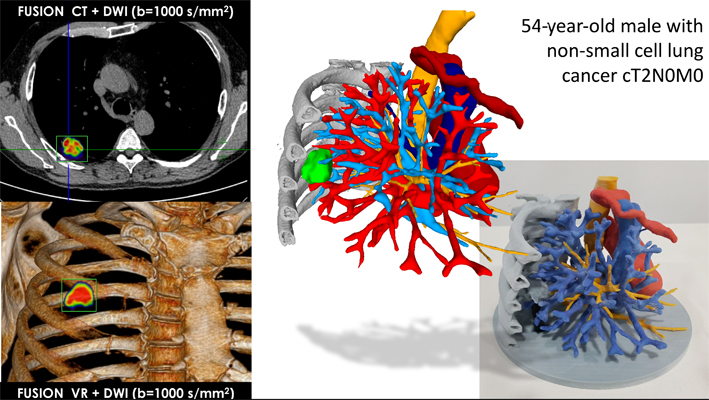Cruz Roja hospital in Córdoba is using 3D printing to prepare for surgeries on lung cancer patients.
As surgeons seek to leverage the benefits of 3D printing for surgical planning, 3D models are finding application in an increasing number of hospitals. Just last week surgeons at American Family Children’s Hospital announced that they are collaborating with engineers to use 3D printed models as a surgical planning tool. And North Manchester General Hospital is one of many to launch its own 3D printer lab.
Greater detail with hybrid scanning
The 3D models used at Cruz Roja were created by combining data from CT and MRI scans of patients suffering from lung cancer. CT scans provide excellent anatomical detail and are generally used in the initial evaluation of lung cancer. MRI scans are used for determining the stage of cancer and detecting metastasis, the form of cancer that spreads to different parts of the body.

The scans were merged into a hybrid 3D image using a clinical visualisation and quantification platform, Phillips’ IntelliSpace Portal. The platform features a built in 3D modeling application that enables clinicians to intuitively integrate 3D models into their workflow. It is the same platform used by Phoenix Children’s Hospital in Arizona which is pioneering the use of 3D printed hearts for surgical planning.
Management of the large image data was handled by Meshlab, an open-source mesh processing system which provides tools for cleaning and rendering digital meshes.

Multi-material 3D printing realises complex anatomical scans
Lung models were 3D printed on 3D Systems’ MultiJet ProJet MJP 5600. A key feature of the MJP 5600 is its multi-material capabilities which allow the use of up to five base materials and over 100 composite combinations to produce high-definition, multicolor parts. These features made it suitable for clearly reproducing the complex anatomical lung models.
3D Systems is also in a partnership with Materialise a company that also has an agreement with Siemens Healthineers to bring more 3D services to radiologists.

Real practical benefits for patients
Cruz Roja surgeons found the use of 3D models reduced intraoperative time by an average of 30.6 minutes and hospitalization time by 1.9 days.
One of the surgeons at the hospital, Dr Jordi Broncano said, “3D printing constitutes a novel and potentially useful technique available for treatment planning and learning improvement. Although its impact is still to be proved, this procedure could improve surgery planning, especially in complex operations.”
Cruz Roja hospital is the latest in a long list to discover the benefits of 3D printing for surgical preparation. Surgeons at Rady Children’s Hospital in San Diego have reduced surgery time by 25 percent, saving an average of $2700 per surgery. Hospitals in the UK have been using 3D printing to reduce surgery times since 2014.
Vote now in the 2018 3D Printing Industry Awards.
For all the latest 3D printing news – subscribe to the 3D Printing Industry newsletter, follow us on Twitter, and like us on Facebook.
The 3D Printing Industry Jobs is live. Post a job or discover your next career move now.
Protolabs is sponsoring the 2018 3D Printing Industry Awards design competition. Submit your entries now with the chance of winning a 3D printer.
Featured images shows hybrid scans merged with Phillips’ IntelliSpace Portal and edited with Meshlab. Image via Dr Jordi Broncano.

